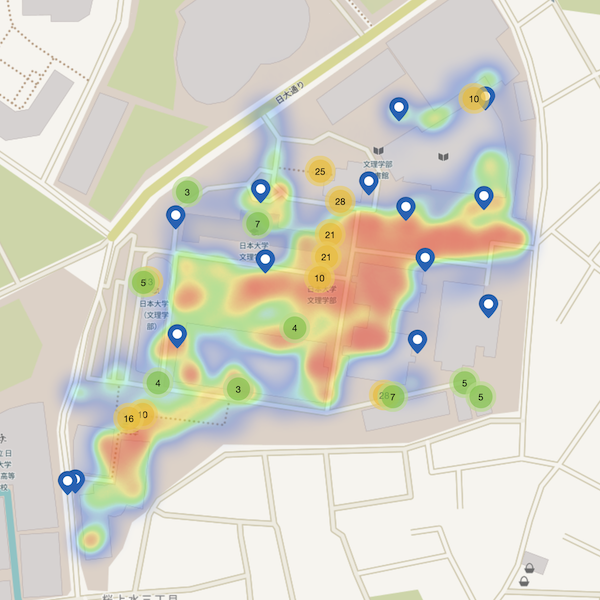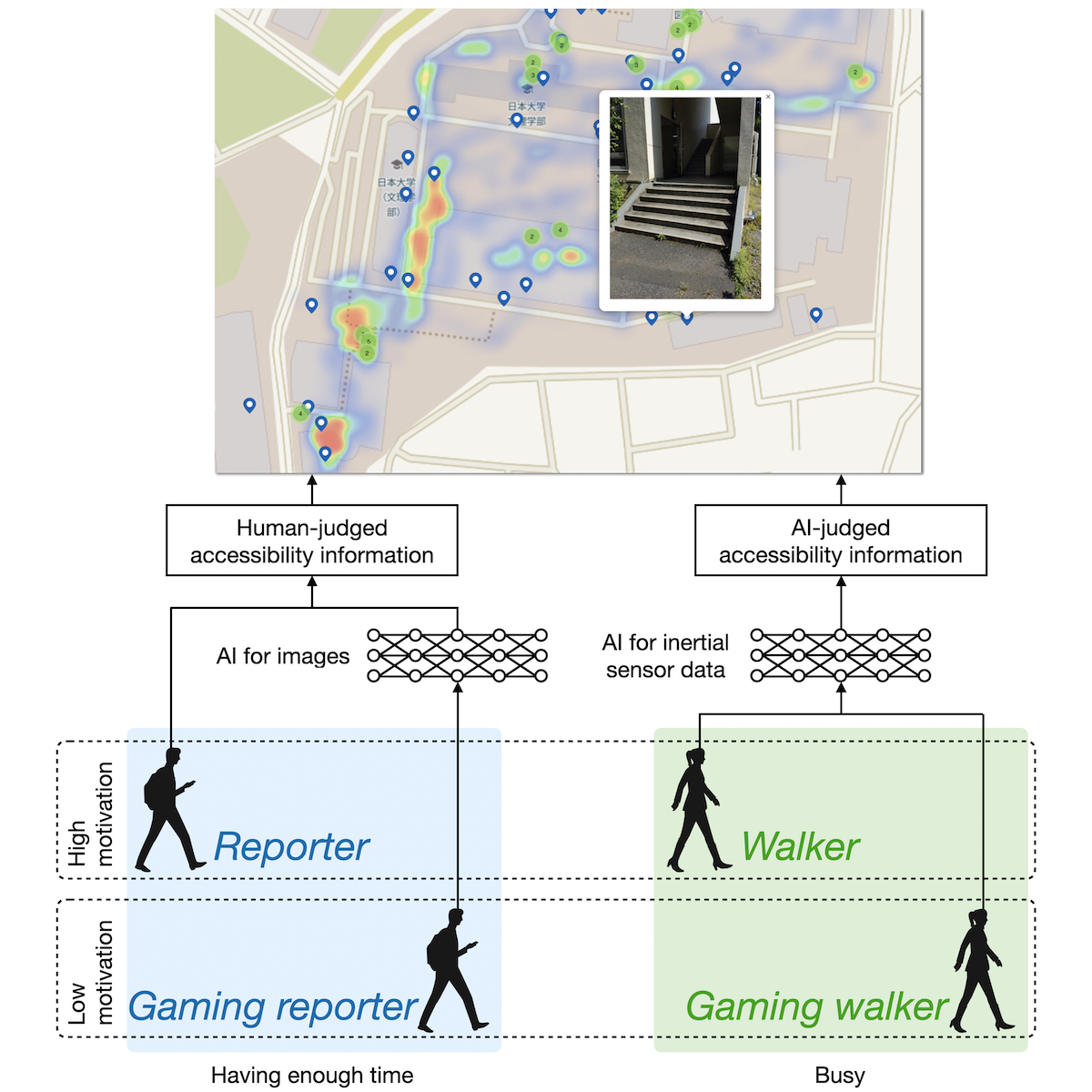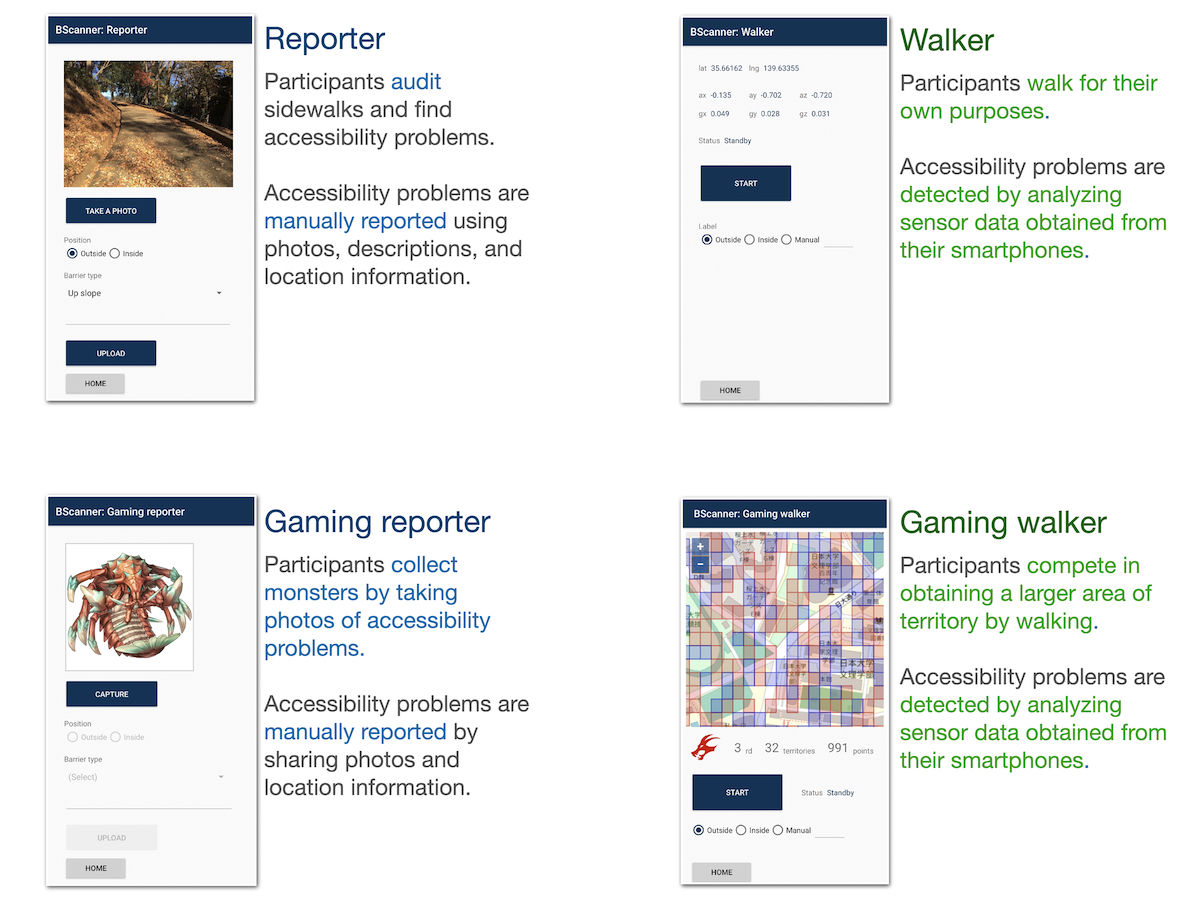BScanner
Accessibility maps enable impaired/elderly people to move around more smoothly and with less risk. However, very few examples satisfy both the accuracy and coverage requirements, owing to the high cost of physically auditing everchanging roads and pathways. Although crowdsourcing approaches can ostensibly solve this problem, existing studies have relied on volunteers with free time and high motivation.
To address this issue, we propose a crowdsourcing platform for constructing accessibility maps to support four participation modes: Reporter for people having plenty of free time and high motivation; Gaming reporter for people having plenty of free time but with low motivation; Walker for people lacking enough free time but with high motivation; and Gaming walker for people lacking enough free time and with low motivation. This design allows people to select a suitable participation method, depending on their time and motivation.
Demo
https://miyata.is.chs.nihon-u.ac.jp/bscanner/

Client application(Android)
Concept movie
Journal articles
- Akihiro Miyata: Differences in Perspectives between Facility Managers and Crowd Workers in Accessibility Mapping. Journal of Information Processing, Vol.33, pp.2–8 (2025).
- Akihiro Miyata and Kazuki Okugawa: A Comparative Study of Neural Network Structures for Detection of Accessibility Problems. Transactions of the Virtual Reality Society of Japan, Vol.25, No.3, pp.174–180 (2020).
International conferences
- Akihiro Miyata, Riki Tokita, Kenro Go, Eriko Tanaka, and Yusuke Ichikawa. Cross-Site Comparison of Crowdsourced and Authoritative Accessibility Maps. Extended Abstracts of the 2025 ACM CHI Conference on Human Factors in Computing Systems (CHI EA ’25), Article No.160, pp.1–8 (2025). [Full-text available]
- Akihiro Miyata. How Do Facility Managers and Crowd Workers Differ in Their Approach to Accessibility Mapping? Companion Publication of the 2024 ACM Designing Interactive Systems Conference (DIS ’24 Companion), pp.144–148 (2024). [Full-text available]
- Yusaku Murayama, Akihiro Furuta, Keihiro Ochiai, Yuko Murayama, and Akihiro Miyata: Case Study on Student Behavior of Barrier Image Collection through Gaming. Proc. 35th Australian Conference on Human-computer-interaction (OzCHI ’23), 159–165 (2023).
- Akihiro Miyata, Kazuki Okugawa, Yusaku Murayama, Akihiro Furuta, Keihiro Ochiai, and Yuko Murayama: Case Study: In-the-Field Accessibility Information Collection Using Gamification. In Proceedings of the 20th International Web for All Conference (W4A ’23) (2023). [Full-text available]
- Akihiro Miyata, Yusaku Murayama, Akihiro Furuta, Kazuki Okugawa, Keihiro Ochiai, and Yuko Murayama: Gamification Strategies to Improve the Motivation and Performance in Accessibility Information Collection. Extended Abstracts of the 2022 ACM CHI Conference on Human Factors in Computing Systems (CHI EA ’22), Article No.355, pp.1–7 (2022).
- Kazuki Okugawa, Tadashi Maeda, Yuko Murayama, Keihiro Ochiai, and Akihiro Miyata: Behavioral Survey of Volunteers in Barrier-Free Photography Work. Proc. 24th International Conference on Human-Computer Interaction (HCII ’22), HCI International 2022 Posters, Communications in Computer and Information Science, Vol.1580, pp.570–575 (2022).
- Akihiro Miyata, Kazuki Okugawa, Yuki Yamato, Tadashi Maeda, Yusaku Murayama, Megumi Aibara, Masakazu Furuichi, and Yuko Murayama: A Crowdsourcing Platform for Constructing Accessibility Maps Supporting Multiple Participation Modes. Extended Abstracts of the 2021 ACM CHI Conference on Human Factors in Computing Systems (CHI EA ’21), Article No.419, pp.1–6 (2021).
- Akihiro Miyata, Kazuki Okugawa, Yuki Yamato, Megumi Aibara, Masakazu Furuichi, and Yuko Murayama: BScanner: A Crowdsourcing Platform for Constructing Accessibility Maps to Support Multiple Participation Types. Proc. 32nd Australian Conference on Human-computer-interaction (OzCHI ’20), pp.666–670 (2020).
- Yuki Yamato, Kenro Go, and Akihiro Miyata: Gamification Approach for Gathering Barrier Information. Poster Proc. the 25th International Conference on Collaboration Technologies and Social Computing (CollabTech 2019), pp.35–38 (2019).
- Akihiro Miyata, Iori Araki, and Tongshun Wang: Barrier Detection Using Sensor Data from Unimpaired Pedestrians. Proc. 20th International Conference on Human-Computer Interaction (HCII ’18), Lecture Notes in Computer Science, Vol.10908, pp.308–319 (2018).
- Takashi Isezaki, Arinobu Niijima, Akihiro Miyata, Tomoki Watanabe, and Osamu Mizuno: Wheelchair Users’ Psychological Barrier Estimation Based on Inertial and Vital Data. Proc. 18th International Conference on Human-Computer Interaction (HCII ’16), Lecture Notes in Computer Science, Vol.9738, pp.403–413 (2016).
Invited talks
- Akihiro Miyata: Assistive Technology based on Crowdsourcing and VR. Creating Inclusive And Accessible Technology Through Immersive Interactions, Birds of a Feather, SIGGRAPH Asia 2020 (2020).
Related project
Part of this project (-2016) was conducted when Miyata worked for NTT Service Evolution Laboratories.

